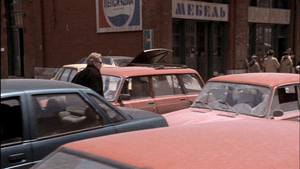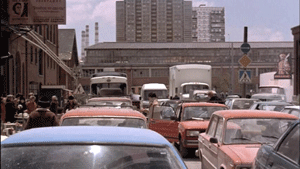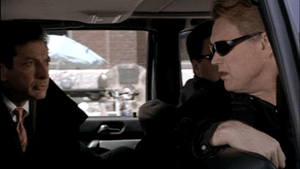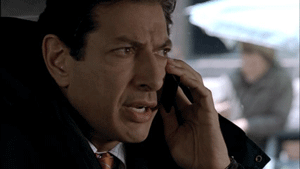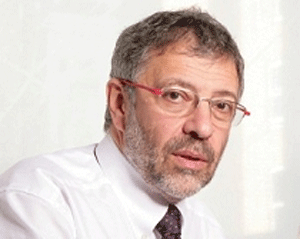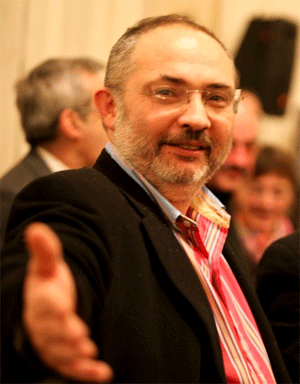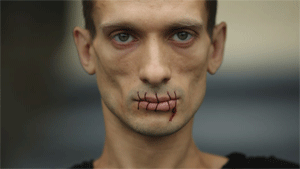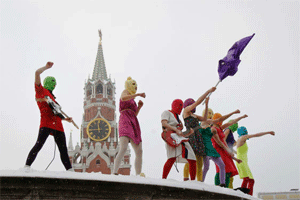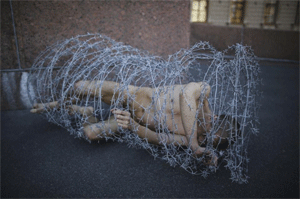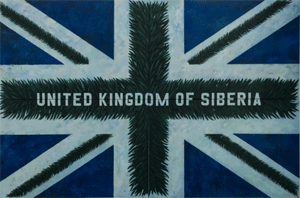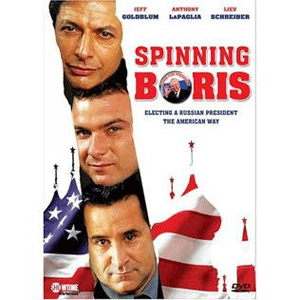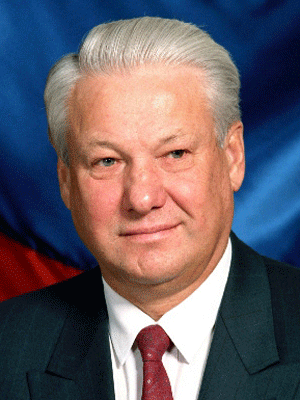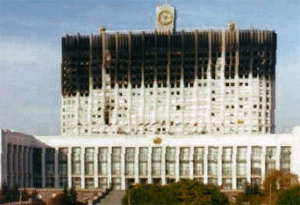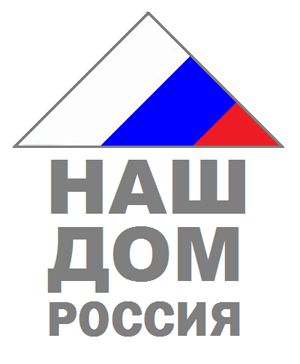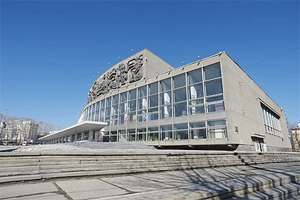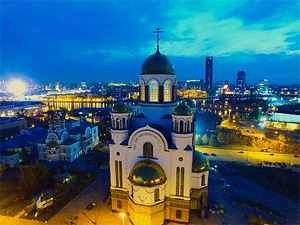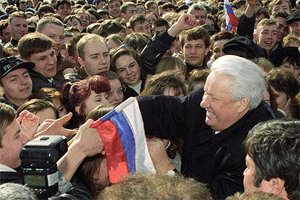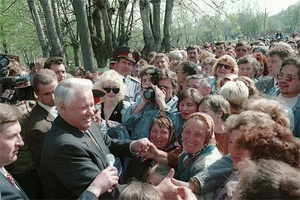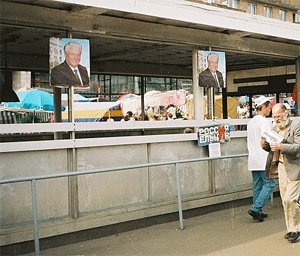Part 2 of 2
Economic policyYeltsin promised to complete his economic reform, insisting that the reforms that had already been initiated should be carried-through.[44][10] However, in an effort to boost his popularity, Yelstin promised to abandon some of his more unpopular economic reform measures.[8] Yeltsin's enthusiasm for reform was markedly different than it had been in the early years of his presidency. Yeltsin now championed a more cautious and gradual approach to reform.[10]
Yeltsin also promised to rewrite the tax code and to compensate swindled investors.[44]
In late January and early February Yeltsin made promises to spend billions of dollars in support of coal miners in order to end workers strikes.[44][13] This was the first of many populist spending promises Yeltsin would make during his campaign.[13]
Yelstin promised to pay wages and pension arrears[8] and to raise pensions.[19] In March, to demonstrate a willingness to deliver on his promises, Yeltsin doubled many pensions.[31]
Yeltsin promised easier loans to buy homes.[44]
Yeltsin promised to provide compensation to those that had lost their savings through the hyper-inflation of 1991-92. Such payments would be distributed in a manner prioritizing war veterans, the disabled, and elderly.[44]
Yeltsin promised farmers that he would cut their electricity expenses in half and would forgive nearly 23 trillion rubles in farm debt.[44]
MilitaryYeltsin promised to turn the nation's army into a modern professional fighting force. Yeltsin adopted a position favoring the abolition of conscription, proposing a gradual end to the policy to be completed by the year 2000.[44]
Yeltsin believed that Russia needed to ensure its military security, spite a decrease in world tensions. He condemned NATO expansion saying that the West was trying to '"reinforce its world leadership." Yeltsin also called for military reform to adjust to the new strategic situation, arguing that instead of hundreds of divisions that exist only on paper, Russia's military needed, "a few dozen divisions made up of entirely professionals."[44]
Yeltsin pledged to spend 2.8 trillion rubles on for research and development for defense sector.
Yeltsin called for adopting a strong nuclear deterrent policy.[44]
Ending the Chechen WarYeltsin attempted to separate himself from taking responsibility for the unpopular military action in Chechnya, instead contending that his ministers should be the ones blamed.[10]
Yeltsin pledged to end the war in Chechnya.[8][53] He also promised to spend trillions of rubles rebuilding the war-torn region.[44] During his campaign, Yeltsin falsely claimed that he was already achieving a peaceful end to the conflict. He even went as far as erroneously denying reports that armed conflict was actively ongoing.[31] Yeltsin saw his candidacy as tilting upon the public's perception of his ability to deliver a peaceful to the conflict.[32]
On March 31, in a televised speech to the nation, Yeltsin announced his long-awaited peace initiative for Chechnya. He conceded that his administration would be willing to hold discussions with Chechen leader Dzhokhar Dudayev, and would be willing to discuss some form of autonomy for Chechnya within the Russian Federation short of outright independence, perhaps modeled upon Tatarstan. He named Prime Minister Chernomyrdin, who was more favorably viewed by Chechens, as heading these efforts. He announced that troops would be withdrawn from areas already secured. He also announced amnesty would be granted to most Chechen fighters. However, in a deft political move, Yeltsin declared that the decisions as to which Chechens would be granted amnesty would be decided by the State Duma, which was controlled by the Communist Party.[32]
On May 27, Yeltsin's efforts received a boost when he and acting Chechen President Zelimkhan Yandarbiyev signed a cease-fire agreement.[44] This temporarily suspended military operations in the Chechen Republic.
Social policy
WelfareYeltsin promised to increase welfare spending and strengthen the nation's social welfare system.[8][44]
Yeltsin promised to provide free transportation to the elderly.[19] He also promised a significant increase in the amount of money given in monthly pensions.[44]
Yelstin promised that, for frozen regions of Northern Russia, he would subsidize children's holidays and build retirement homes in the south for their miners.[44]
Yeltsin promised to provide students with scholarships for science students, and better pension plans for teachers.[44]
Soviet reunificationYeltsin made efforts to one-up the nationalists and communists on the issue of Soviet reunification by taking concrete actions. Yeltsin announced a series of agreements with states of the former Soviet Union pertaining to voluntary reunification.[32]
On April 2, Yeltsin and president Alexander Lukashenko of Belarus signed a treaty calling for further cooperation between the two nations.[32][54] The treaty would establish a Union State. It would also establish a "Community of Sovereign Republics" that would include supranational bodies for the military, environmental, and technical fields. A common currency was envisioned by 1997, to be followed by a joint budget and constitution afterwards. However, the nations would keep their own flags and continue to be sovereign states.[32]
Image managementWithin the campaign council, Malashenko was tasked with managing television advertising and enhancing the president's image.[1] Additionally involved in shaping Yeltsin's image was Georgy Rogozin, who was given offices on the eighth floor of of the President-Hotel.[20]
The campaign council hired the country's leading campaign advisers, image consultants and advertising agencies.[1] Igor Mintusev and Yekaterina Yegerova of the campaign consulting firm Nikola M were both hired to work on Yeltsin's image.[1] The campaign also employed a number of media consultants, who were tasked with placing favorable articles in national and regional publications.[1]
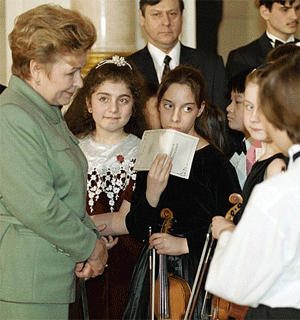 Normally a private individual, Naina Yeltsina (left) made herself more available to the public
Normally a private individual, Naina Yeltsina (left) made herself more available to the publicDuring the campaign, Yeltsin's wife, Naina Yeltsina, normally a private individual, took a more public role, and met with the voters.[55]
The campaign made use of a number of catch-phrases, including "chose or lose" and "vote with your heart".[56]
Personal health of YeltsinAt 65 years old,[45] Yeltsin's health had been in grave decline, with his heavy consumption of alcohol being a contributing factor.[9] By the time he had announced his reelection effort, Yeltsin was facing significant health problems. He was recovering from a series of heart attacks.[8][9] In 1995 alone, Yeltsin had suffered three heart attacks.[9]
Yeltsin campaigned energetically during the first round of the election in an effort to dispel concerns about his health.[8] Nonetheless, it was visible that his health was indeed declining while he was on the campaign trail.[45] For the benefit of his health while campaigning, Yeltsin temporarily gave up his heavy drinking.[30]
Yeltsin's campaign worked to conceal his ailing health from the public.[1][51]
Scandals during campaign
Xerox Affair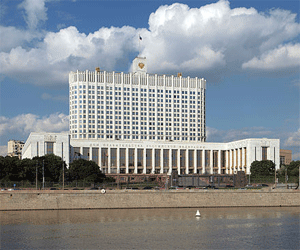 Staffers were detained while leaving the Russian White House
Staffers were detained while leaving the Russian White HouseOn June 20, only three days after the first-round of voting, Yeltsin fired Soskovets, Korzhakovand and Barsukov from their roles in his presidential administration. Yeltsin alleged that the three had been interfering in his reelection campaign.[47] As noted earlier, Soskovets had drafted Yeltsin's original, abandoned, campaign strategy, and originally oversaw the campaign alongside Korzhakov and Barsukov.[1] All three had subsequently come into conflict with the new leaders of the campaign.[47]
The controversy stemmed from the June 19 arrest of two campaign staffers, Sergey Lisovsky (the general director of the company ORT-advertising) and Arkady Evstafiev (an assistant to Cubais). The two had been detained by security agents while leaving the Russian White House.[47][57] The security agents discovered $500,000 in a Xerox copy-paper box that was being carried by one of the men.[57] The men were arrested and interrogated at the behest of Barsukov and Korzhakov.[47][57]
The motivation of Barsukov and Korzhakov for arresting the men had likely been Korzhakov's resentment towards campaign manager Antoly Chubais. Korzhakov had been a key individual urging Yeltsin to postpone the election.[16][47] He had earlier caused a media frenzy in early May by publicly asserting the opinion that Yeltsin should postpone the election.[16] Distrusting and disagreeing with Chubais, Korzhakov and the others were likely attempting to filthy Cubais in Yeltsin's eyes.[47]
The arrests had been reported within hours by television networks, which led to the firing of Barsukov and Korzhakov, along with their political ally Soskovets. Both Chubais and Lebed quickly convinced Yeltsin that he would lose the election if he kept the three in his administration. Yeltsin desired to distance himself from any corruption investigation that might result from the event, and therefore obliged to the firings.[47]
The discovery of the $500,000 raised the public's suspicions of chicanery being conducted by Yeltsin's campaign. Chubais publicly proclaimed that such allegations were merely the work of political adversaries. However, he privately conspired to cover-up any evidence of illegal transactions.[58]
Media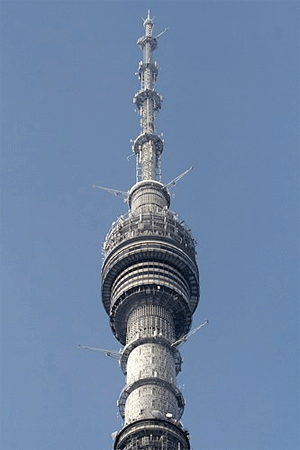 A television tower in Moscow
A television tower in MoscowYeltsin's campaign organized the most sophisticated media effort that Russia had ever seen.[3] While the Communist campaign relied on old-school techniques, such as campaign rallies and leafletting, Yeltsin's team commissioned firms to conduct focus-group research, polling, consulting, and direct mail advertising on behalf of campaign.[16]
Throughout the first round of the election, Yeltsin maintained a high level of media presence.[8][6] His approval benefited from this.[6] Additionally, his wife, normally a private individual, made herself available for interviews with the media.[55]
In March 1996, NTV general director Igor Malashenko was made a member of Yeltsin's newly-established campaign council.[1] Within the campaign council, Malashenko was tasked with managing television advertising and enhancing the president's image.[1][59] Malashenko commissioned Video International, the same firm that supplied NTV with most of its advertising and television programming, to produce television sports, posters and leaflets for the campaign.[1][16] He awarded additional contracts for direct mail and posters to Mikhail Semenov, who owned Russia's largest direct mail firm.[1]
Rather than asking voters whether they were better off under his leadership, Yeltsin's campaign sought to ask voters whether they believed they would be better or worse off under Zyuganov's leadership.[29]
Favorable media bias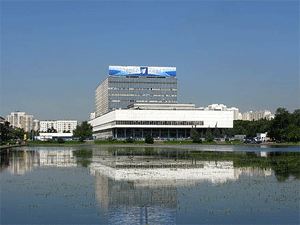 Ostankino Technical Center
Ostankino Technical CenterThe Yeltsin campaign successfully enlisted the national television channels (ORT, RTR, NTV) and most of the written press as agents in his campaign against Zyuganov.[1][29]
Supplementing the work of the numerous public relations and media firms that were hired by the campaign, a number of media outlets "volunteered" their services to Yeltsin's reelection effort. For instance, Kommersant (one of the most prominent business newspapers in the country) published an anti-communist paper called Ne Dai Bog (meaning, "God forbid").[1] At ORT, a special committee was placed in charge of planning a marathon of anticommunist films and documentaries to be broadcast on the chanel ahead of the election.[1]
In the 1991 election, there were two major television channels. RTR had supported Yeltsin, while Public Television of Russia had criticized him and covered the views of a large number of his opponents. In the 1996 election, however, no major television network was critical of Yeltsin.[29][60] The networks marginalized all of Yeltsin's opponents aside from Zyuganov, helping to create the perception that there were only two viable candidates. This allowed Yeltsin to pose as the lesser-evil. Near the end of the election, however, the networks began also providing coverage to the candidacy of Lebed,[60] who had already agreed to support Yeltsin in the second round.[1]
The European Institute for Media found that Yeltsin received 53% of all media coverage of the campaign, while Zyuganov received only 18%. In their evaluation of the biases of news stories, EIM awarded each candidate 1 point for every positive story they received and subtracted a point for every negative story they received. In the first round of the election, Yeltsin scored +492 and Zyuganov scored -313. In the second round of the election, Yeltsin scored +247 and Zyuganov scored -240.[29]
One of the reasons for the media's overwhelming favoritism of Yeltsin was their fear that a Communist government would dismantle Russia's right to a free press.[29][5]
There were instances of direct payments made for positive coverage (so-called "dollar journalism").[29]
Another factor contributing to the media's support of Yeltsin was that his government still owned two of the national television channels, and still provided the majority of funding to the majority of independent newspapers.[29] In addition, Yeltsin's government also was in charge of supplying licenses to media outlets. Yeltsin's government and Luzhkov, mayor of Moscow, flexed their power and reminded the owners, publishers, and editors that newspaper licenses and Moscow leases for facilities were "under review".[29]
Additionally, Yeltsin managed to enlist Russia's emerging business elite in his campaign, including those who ran media corporations. This included Vladimir Gusinsky, owner of Most Bank, Independent Television and NTV. NTV which had, prior to the campaign, been critical towards Yeltsin's actions in Chechnya, changed the tone of their coverage. Igor Malashenko, Gusinsky's appointed head of NTV, even joined the Yeltsin campaign and led the its media relations in a rather visible conflict-of-interest.[29] In early 1996, Gusinsky and his political rival Boris Berezovskii (chairman of the Board of ORT) decided that they would put aside their differences in order to work together to support the reelection Boris Yeltsin.[1]
In mid-1996, Chubais and Yeltsin recruited a team of a handful of financial and media oligarchs to bankroll the Yeltsin campaign and guaranteed favorable media coverage the president on national television and in leading newspapers.[61] In return, Chubais allowed well-connected Russian business leaders to acquire majority stakes in some of Russia's most valuable state-owned assets.[62] Led by the efforts of Mikhail Lesin, the media painted a picture of a fateful choice for Russia, between Yeltsin and a "return to totalitarianism." The oligarchs even played up the threat of civil war if a Communist were elected president.[63]
Additionally, to further guarantee consistent media coverage, in February Yeltsin had fired the chairperson of the All-Russia State Television and Radio Broadcasting Company and replaced him with Eduard Sagalaev.[64][65]
While the anti-communist pro-Yeltsin media bias certainly contributed to Yeltsin's victory, it was not the sole factor. A similar media bias in the run-up to the 1995 parliamentary elections had failed to prevent a communist victory.[4]
AdvertisingEarly advertising for the campaign sought to portray Yeltsin as a "president for all". Early billboards of the campaign included slogans such as "Yeltsin is our president" and "Yeltsin is president of all Russia".[6]
One particularly American-style campaign tactic that Yeltsin adopted was the use of direct mail letters.[42]
Television commercialsBefore the election, it was originally predicted that Yeltsin's television advertisements would likely resemble those that had been run by Our Home Is Russia in the week prior to the 1995 legislative elections. One such advertisement that had been run by Our Home Is Russia in 1995 featured a man on the street interview of voters, with respondents either replying Our Home Is Russia or the Communist Party. Those supporting the Communist Party were shown to be far more slovenly than those supporting Our Home Is Russia. This particular ad had conveyed an image of a close two-party race (in spite of reality being that Russia's political landscape was then a multi-party system) in order to urge voter turnout. This type of advertisement was seen as having the advantage of scaring voters into supporting Yeltsin as the lesser-evil, and encouraging turnout by portraying a razor-thin race. However, it was also seen as having the disadvantage of reminding the voters that they could vote for Zyuganov if they wish to see Yeltsin removed from office, essentially providing free advertising to the Zyuganov campaign.[21]
Yeltsin's television campaign mainly focused on repairing his own image, rather than issuing attack ads on Zyuganov.[3] The challenge his campaign faced was that, due to Yeltsin's negative ratings and overexposure on television, it was believed he could not effectively deliver his campaign pitch himself. Instead, the pitch would need to be delivered indirectly. This meant that advertisements would not feature Yeltsin himself. A barrage of advertisements were released which featured working-class Russians, veterans, and elderly people providing testimonials in support of Yeltsin's leadership. The groups that were portrayed in these ads were demographics which typically voted for the communist party. Therefore, these ads aimed these testimonials towards peeling-away voters from demographics that typically leaned communist.[3][16]
Yeltsin's television advertising campaign avoided addressing difficult issues, such as the faltering economy.[3] Mikhail Margelov, the head of Video International, said,
We didn't want political or economic discussions. We decided to play on the field of basic human values ... people talking about their lives and basic values. If we came to a discussion of economic problems or crime, it's easy to criticize Yeltsin for that.[3]
Russian law prevented candidates from running advertisements before March 15. However, despite of this regulation, the Yeltsin campaign began broadcasting a set of campaign commercials under the guise of "public service announcements" earlier than was permitted. The Russian airwaves were flooded during on Victory Day with videos in which World War II veterans recalled their service and hinted at an ominous future under communist leadership. In one such video, a veteran remarked, "I just want my children and grandchildren to finally savor the fruits of the victory we fought for."[42]
FinancesElection laws specified that campaigns could spend up to $2.9 million.[29] The campaign claimed that its official expenditures were $3 million.[3] This amount does not accurately reflect the amount that was spent towards his campaign in both "unofficial" expenditures and outside expenditures.[3] Estimates of the cost of Yeltsin's campaign extended into the hundreds of millions of dollars.[29]
Yeltsin had run continuous television advertisements that were purchased at $15,000-$30,000 per minute. He employed a large campaign staff, traveled extensively, and distributed enormous amounts of high-quality campaign material.[29]
Yeltsin's campaign effort received immense financial backing from the business community.[3]
Additionally, Yeltsin's government found it necessary to force the Central Bank to provide it an extra $1 billion to fund the campaign promises before the election.[29]
Support from business communityAn advantage of incumbency that the campaign benefited from was Yeltsin's ties to Oligarchs. Oligarchs gave significant funding to Yeltsin's campaign. Oligarchs that had benefited under his leadership felt obliged to support him in order to secure their own positions. Oligarchs believed that a communist victory would be devastating for them.[1] Amongst the oligarchs supporting Yeltsin were seven that subsequently were dubbed "Semibankirschina".
Oligarchs and businesses provided the campaign an amount that was estimated to be between $100 million and $500 million.[3] However, as mentioned earlier, the official campaign spending was reported to be a mere $3 million.[3]
In order to begin to deliver on his campaign promises before the day of the election, Yeltsin ordered $1 billion dollars to be issued by the Central Bank to pay for his campaign pledges.[44]
Loans for shares schemeWith the election approaching, strengthening support from Russia's new private business elite was believed to be critical to Yeltsin's reelection effort.[66] Beginning in 1995, Yeltsin's government began to use a loans for shares scheme in privatizing state-owned shares in companies.[3] The auctions were rigged, being non-competitive and frequently controlled by favored insiders with political connections.[67] The scheme was structured in a manner that made Yeltsin's victory a strong interest of the investors involved. The two-stage program was structured so that the loans would be made before the election, but the auction of the shares could only take place beginning after the election, making it of financial concern for them that Yeltsin would win the election.[66]
Low-cost bonds schemeDavid E. Hoffman of The Washington Post reported that, during the election effort, Russian oligarchs profited from special deals involving low-cost government bonds. This, consequentially, sweetened the business communities support of Yeltsin's reelection effort.[66]
Campaign organizations
Central campaign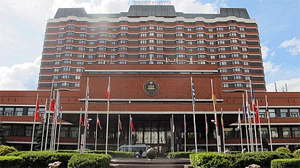 The campaign's headquarters were in the President-Hotel
The campaign's headquarters were in the President-Hotel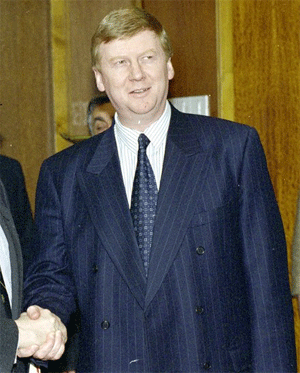 Chubais, who became the head of the campaign
Chubais, who became the head of the campaignOleg Soskovets served as the campaign's original chairman. When it was first launched, the campaign's structure consisted solely of a campaign management team led by Soskovets. The management team had set-up shop at the campaign's headquarters on the ninth level of the President-Hotel.[1]
Yeltsin ultimately fired Soskovets as his campaign chairman on March 23, and hired Chubais to lead the campaign in his place.[1][3] This represented a key change in the ideological slant of the campaign leadership. While Soskovets was a nationalist hardliner, Chubais was an avid reformer.[1]
Additionally, on March 19, Yeltsin had established new "campaign council" to lead the campaign.[1][27] Notably, this campaign council featured a number of liberals, in contrast to the nationalist hardliners that had been appointed to the initial campaign management team.[1] Among those that Yeltsin appointed to the newly-formed campaign council was Viktor Ilyushin, one of the predominate Kremlin insiders who urged him to abandon Skoskovets' campaign strategy.[1] Additionally, after firing Soskovets as the head of his campaign, Yeltsin invited a number of shadow campaign groups to merge their operations with his official campaign effort. In doing so, Yeltsin handed-over much of the many responsibilities of the campaign to these groups.[1]
After integrating various organizations that had been supporting his candidacy, the structure of the central campaign lacked cohesion. Additionally, after the initial creation of the campaign council, the campaign briefly acquired complicated leadership arrangement.[1] Yeltsin had not dissolved the original Soskovets campaign management team. While its leadership had joined the campaign council, they also continued to work independently and maintained offices on a separate floor from the rest of the campaign council members.[27] Between both the campaign council and the original management team (which had not been dissolved), the campaign had acquired two competing leadership groups.[1] However, the campaign council quickly emerged as the predominant leadership group, and ultimately negated the authority of the management team. Consequentially, with the campaign council emerging as the campaign's predominate leadership, liberals were in charge of a campaign that (under its original management team) had previously been run by nationalist-leaning hardliners.[1]
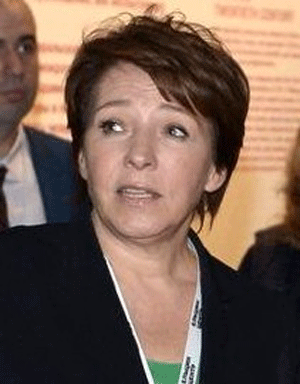 Yeltsin's daughter Tatyana Dyachenko was a key figure, serving as the de-facto co-head of the campaign
Yeltsin's daughter Tatyana Dyachenko was a key figure, serving as the de-facto co-head of the campaignWhile Chubais was the official head of the campaign, being named both Yeltsin's campaign manager and chairman of campaign council, he managed the campaign largely in tandem with Dyachenko, who was the de-facto co-head of the campaign.[1][20] Dyachenko coordinated much of the campaign from her Motorola cell phone.[68][69] Dyachenko used her phone very frequently to remain in constant contact with both her father and with members of the campaign operations.[69] She served as the primary conduit of communication between Yeltsin and his campaign operation.[29][20]
Yury Yarov served as the campaign's executive head.[20]
Also involved in the central campaign was Georgy Rogozin, who was in charge of security, as well as some image-management. Rogozin was given offices on the eighth floor of the President-Hotel.[20] Dyachenko also recruited her associate Viktoriya Mitina to work for the campaign.[20]
Members of the campaign council• Mikhail Barsukov -fired after Xerox Affair[1][47]
• Viktor Chernomyrdin[1]
• Anatoly Chubais chairman[1]
• Tatyana Dyachenko[1]
• Viktor Ilyushin[1]
• Alexander Korzhakov -fired after Xerox Affair[1][47]
• Yury Luzhkov[1]
• Igor Malashenko[1][21]
• Sergei Shakhrai[1]
• Yury Yarov[1]
• Nikolai Yegorov[1]
Ilyushin oversaw the overall campaign operations.[29] He exerted strategic control over the campaign.[20] Dyachenko was in charge of personal contact between Yeltsin and the campaign.[29][20] Chubais was in charge of the campaign's finances.[29] Chernomyrdin was in charge of financial policy.[52] Malechenko was responsible for media relations. Luzkhov led the campaign efforts within the city of Moscow.[29][15]
Analytical groupOn March 19, simultaneously to forming the campaign council, Yeltsin also impaneled an "analytical group" to be led by Chubais.[27] The organization enlisted the work of Dyachenko, Malashenko, Illyushin and Saratov as well as Valentin Yumashev, pollster Aleksandr Oslon, Vasily Shakhnovsky (chief of staff to Moscow's Mayor Luzhkov), Media-Most executive Sergei Zverev, and Duma deputy (and former deputy premier) Sergei Shakhrai.[27]
Foreign consultantsFlush with money, the central campaign hired an extensive amount of contractors for its campaign efforts. Most major research groups, think tanks, and public relations firms in Russia, at one point, worked for the campaign.[1] However, with Russians being relatively new to electoral politics, the campaign campaign also solicited the advice of private consults from abroad.[18][28] Among those advising the campaign was Tim Bell, a British political strategist that had helped shape the public-image of former British Prime Minister Margaret Thatcher.[16]
Team of AmericansA team of American political consultants (including George Gorton, Joe Shumate, Richard Dresner) advised the campaign.[3][18][28] They were hired in February by Soskovets, who hired them through a San Francisco firm with connections in Moscow. They were reportedly paid $250,000 for their consultation.[18][28][70][71] Formally, their role was as advisors to the Yeltsin family.[18] The team was given an unlimited budget with which to conduct focus groups and research.[28]
By this time, it was not unusual for experienced American consultants to be recruited to Russian campaigns. However, Yeltsin's team did not want to risk allowing Zyuganov to exploit their presence in the Yeltsin campaign as a means to lodge xenophobia-laden attacks on Yeltsin.[3] They especially worried that the involvement of foreign consultants might play negatively in the particularly nationalistic tone of the 1996 election.[3] Yeltsin's team of American political consultants was kept isolated from the rest of the campaign, and remained a secret until after the election was over.[3][45] They never met with Yeltsin himself, but instead sent detailed and unsigned memos to Dyachenko, with whom they worked closely.[3][18] They worked out of two suites on the eleventh floor of the President-Hotel, directly across the hall from Dyachenko's office.[70] To hide their involvement, the group claimed to be American businessmen conducting consumer research.[18]
Much of their advice proved to be obvious and redundant, however. While they subsequently claimed to have played a critical role in the campaign, this has been refuted by others in the campaign.[70] Dyachenko, for instance, reported that none of their contributions were central to the campaign's planning or strategy.[70][71]
They had no apparent communications with campaign leaders such as Chubais and Malashenko.[70] Because they had been hired by Soskovets, many of those leading the campaign distrusted and disregarded the consultants.[71]
Aleksandr Oslon commented on the role of the American advisors, stating, "when all the real decisions were made, they were not present."[70]
Despite this, the Americans subsequently boasted about their role in the campaign in a Time magazine cover-story which hyperbolically proclaimed, "Yanks to the Rescue".[72][73][71]National campaign structureOutside of its central leadership, the campaign consisted of two parallel structures. One was its formal national campaign organization, the second was an organization composed of outside groups.[1]
Formal national campaign organizationThe formal nationwide campaign was largely overseen by Yarov, also a member of the campaign council. Yarov was responsible for the national campaign's official organizational work. Under his guidance, the campaign employed local representatives all across Russia. The local representatives were typically individuals who served in local governments.[1]
Shakhrai, also a member of the campaign council, assumed a role of coordinating with regional leaders. This was similar to a role that Yegorov occupied on the campaign management team.[1]
All-Russian Movement for Social Support for the President (ODOP)The All-Russian Movement for Social Support for the President (also known as the ODOP) was an organization of Yeltsin's campaign which collaborated with outside groups providing their support to his candidacy. This formed the second nationwide structure of the campaign.[1][32] The ODOP and Chubais' campaign council jointly served as the main drivers of Yeltsin's campaign effort.[1]
Originally, Boris Yeltsin saw support from several political leaders and organizations who each declared themselves to be his candidacy's primary nongovernmental sponsor.[1] Vladimir Shumeyko announced that his social organization/quasi political party Reform's New Course would spearhead Yeltsin's reelection effort. Around the same time, the leaders of Our Home – Russia proclaimed that they were to be Yeltsin's primary campaign organization. After weeks of fighting between the two groups, Sergei Filatov started to form what would be the ODOP. The goal was to create a group that would serve as the campaign's predominant national support structure.[1] The group took on the task of finishing the work to secure the requisite paperwork and signatures to officialize Yeltsin's nomination, a task which it finished by April 5.[27][74] They thereafter convened the ODOP's founding congress on April 6. The founding conference made official the ODOP as an organization. It was immediately the most prominent organized movement supporting Yeltsin's candidacy.[1][27]
The organization drew membership from a vast array of more than 250 preexisting organization,[1][27] including political parties, unions, civic groups and social organization. Among the groups were Reform's New Course, Our Home – Russia, Alexander Yakovlev's Russian Party of Social Democracy, Lev Ponomaryov's Democratic Russia and Arkady Volsky's Russian Union of Industrialists and Entrepreneurs.[1]
The organization was led by Filatov along with Ilyushin.[32] They located the organization's headquarters on the tenth floor of the President Hotel, just above Yeltsin central campaign's offices.[1][20] They hired dozens of campaign managers from various political parties to help run the organization.[1] These included former Press Minister Sergei Gryzonov, Chief of Staff Nikolai Yegorov, and President of the "Politicka" Fund Vyachelslav Nikonov.[32]
People's HouseA sub-organization of ODOP was named "People's House". This organization forged connections with citizen groups and was the unofficial disburser of campaign funds.[32][27] This was also directly overseen by Filatov.[32]
Key members of ODOP leadership• Nikolai Filatov (co-head of ODOP; in charge of PR and People's House)[32]
• Viktor Illyushin (co-head of ODOP; national campaign organizer)[32][6]
• Nikolai Yegorov (in charge of regional work)[32]
• Vyacheslav Nikonov (in charge pre-election analysis)[32]
Moscow campaign organizationA separate campaign organization existed in Moscow, dedicated to rallying votes in the nation's capital, which was a rare bastion of strong support for Yeltsin.[1]
This component of the campaign was established early on. On January 22, it was reported that Moscow mayor Yury Luzhkov had set aside his disagreements with Yeltsin to join his campaign. Luzhkov would be tasked with helping deliver Yeltsin votes in Moscow.[15]
Relations between organizationsWith the exception of Moscow, it was not clarified what organizations were to be the campaign's primary regional representative. Consequentially, four different organizations acted under the separate assumptions that their regional offices were the primary regional representatives of the campaign. In each region, the formal national campaign organization (led by Yarov) would appoint its own representative. The ODOP would appoint their own separate representative as well. Our Home – Russia, despite being a member of ODOP, also would also appoint representatives of their own. A fourth organization, named NarodnyiDom, would also appoint their own representative.[1] In some locations the regional representatives of these organizations worked together, but in other locations there was no coordination between them.[1]
While confusing, having multiple separate organizations also gave significant flexibility to the national campaign. In regions that had strong local parties and civic organizations, the campaign headquarters would often treat the ODOP as their main regional representative. Therefore, the campaign would benefit from the work of the existing grassroots organizations that composed the ODOP. However, in regions with weaker nongovernmental organizations, the campaign headquarters would often treat the official national campaign organization, headed by Yarov, as their main regional representative. This allowed them to avoid being "held hostage" to the demands of grassroots organizations that had little or no local influence.[1]
Outside groupsWhile many outside groups supporting Yeltsin officially coordinated with the campaign through the ODOP, a number outside organizations functioned independently of the campaign.
NarodnyiDomNarodyniDom (народныйдом; English: NationalHouse) was an outside organization supporting Yeltsin's campaign. The official claim was that the nationwide organization provided nongovernmental consultive social services to citizens and that its chapters served a social club for residents with free coffee and occasional entertainment. In actuality, campaign money was funneled through the organization to eschew detection.[1]
Vote or Lose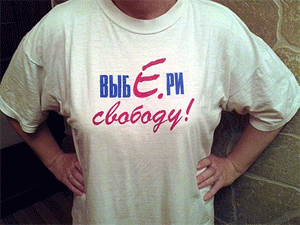 Shirt from the Vote or Lose campaign
Shirt from the Vote or Lose campaignSergey Lisovsky organized the Vote or Lose campaign. Vote or Lose was a $10 million series of television programs and rock concerts in the style of Rock the Vote. It was a get out the vote campaign aimed at mobilizing the youth vote in support of Yeltsin.[1][59]
See also• Russian presidential election, 1996
• Opinion polling for the Russian presidential election, 1996
• Semibankirschina
• Soskovets campaign strategy
• Spinning Boris
• Boris Yeltsin presidential campaign, 1991
References1. McFaul, Michael (1997). Russia's 1996 Presidential Election: The End of Polarized Politics. Stanford University in Stanford, California: Hoover Institution Press.
2. "Плакат с автографами членов предвыборного штаба Бориса Ельцина. Зал музея Бориса Ельцина «День пятый. "Голосуй или проиграешь"»".
http://www.yeltsin.ru (in Russian). Boris Yeltsin Presidential Library. n.d. Retrieved September 11, 2017.
3. Hockstader, Lee; Hoffman, David (July 7, 1996). "Yeltsin Campaign Rose from Tears to Triump".
http://www.washingtonpost.com. The Washington Post. Retrieved September 11, 2017.
4. Brudny, Yitzhak M (1997). "In pursuit of the Russian presidency: Why and how Yeltsin won the 1996 presidential election". Communist and Post-Communist Studies. 30 (3): 255. doi:10.1016/S0967-067X(97)00007-X.
5. Nichols, Thomas S. (1999). The Russian Presidency, Society and Politics in the Second Russian Republic. St. Martin’s Press.
6. Smith, Kathleen E. (2002). Mythmaking in the New Russia. Ithaca and London: Cornell University Press.
7. Solovei, Valery (1996). "Strategies of the Main Presidential Candidates" (PDF). www2.gwu.edu. GWU. Retrieved February 22, 2018.
8. CNN Interactive: Pivotal Elections: Russian Elections; Candidates: Boris YeltsinArchived 10 March 2007 at the Wayback Machine. (1996)
9. "Boris Yeltsin".
http://www.history.com. History Channel. n.d. Retrieved September 4, 2017.
10.
http://researchbriefings.files.parliame ... P96-70.pdf11. Specter, Michael (June 14, 1996). "Zhirinovsky Savors Russian Kingmaker Role".
http://www.nytimes. New York Times. Retrieved September 17, 2017.
12. "Gennady Zyuganov candidate profile, 1996". CNN. 7 February 1996. Retrieved 3 November 2010.
13. "The Russian presidential campaign in brief".
http://www.upi.com. UPI. July 2, 1996. Retrieved January 25,2017.
14. "Russian Election Watch, January 26, 1996". January 26, 1996. Archived from the original (PDF) on 2000-01-29. Retrieved 2018-01-01.
15. "Russian Election Watch, February 9, 1996". February 9, 1996. Archived from the original on 2000-01-29. Retrieved 2018-01-01.
16. Stanley, Alexandria (May 13, 1996). "With Campaign Staff in Disarray, Yeltsin Depends on Perks of Office". New York Times. New York City. Retrieved October 17, 2017.
17. Россия ЕльцинаArchived 17 April 2012 at the Wayback Machine. // The Wall Street Journal, 24 апреля 2007
18. Randolph, Elanor (July 9, 1996). "Americans Claim Role in Yeltsin Win".
http://www.latimes.com. Los Angeles Times. Retrieved September 2, 2017.
19. Gordon, Michael R. (June 17, 2017). "THE RUSSIAN VOTE: THE HEARTLAND;How Yeltsin Won Over a City That Looked on Him Coldly".
http://www.nytimes.com. The New York Times. Retrieved September 22, 2017.
20. "Russian Election Watch, May 9, 1996". May 9, 1996. Archived from the original on 2001-01-04. Retrieved 2018-07-26.
21. The 1996 Russian presidential election / Jerry F. Hough, Evelyn Davidheiser, Susan Goodrich Lehmann. Brookings occasional papers.
22. Depoy, Erik (1996). "Boris Yeltsin and the 1996 Russian Presidential Election". Presidential Studies Quarterly. 26(4): 1140–1164.
23. Второй, понимаешь
24. «Ельцин не хотел идти на второй срок»
25. «Ельцин был великий интуитивист»
26. Как пресса избирала президента
27. Yeltsin: A Life by Timothy J. Colton
28. Kramer, Michael (July 15, 1996). "Rescuing Boris". 1996. Time. Retrieved September 2, 2017.
29. "Russian Election Watch, Aug. 1, 1996". August 1, 1996. Archived from the originalon 2000-01-29. Retrieved 2018-01-22.
30.
https://www.newyorker.com/magazine/1996 ... he-kremlin31.
http://www.cnn.com/WORLD/9604/22/russia.elex/index.html[full citation needed]
32. "Russian Election Watch, April 8, 1996". April 8, 1996. Archived from the original on 2000-01-04. Retrieved 2018-01-02.
33. "Viktor Chernonyrdin".
http://www.cs.ccsu.edu. CCSU. 1996. Retrieved July 28, 2018.
34.
https://www.nytimes.com/1996/02/23/worl ... llion.html35. Michel, Casey (April 17, 2017). "No, America Didn't Ruin Russian Democracy".
http://www.thedailybeast.com. The Daily Beast. Retrieved July 21, 2018.
36. "10.2 Billion Loan To Russia Approved".
http://www.nytimes.com. New York Times. Reuters. March 27, 1996. Retrieved July 21, 2018.
37. "No. 68, Part I, 4 April 1996".
http://www.friends-parners.org. Friends&Parners. April 4, 1996. Retrieved February 22, 2018.
38.
https://www.washingtonpost.com/archive/ ... 2e8e8bced/39. Laurenzo, Ron (June 7, 1996). "Reformers see Yeltsin as 'last resort'".
http://www.upi.com. UPI. Retrieved February 22,2018.
40. Вторая кампания Бориса Ельцина - 1996
41. §1. Выборы Президента РФ в 1996 году. «Семья»: победа любой ценой
42. "Russian Election Watch, May 15, 1996". May 15, 1996. Archived from the original on 2000-01-27. Retrieved 2018-01-01.
43. Heads Of City And Region Administrations Of The Rostov Oblast Regional Headquarters of Yeltsin support (June 1996). "Recommendations On Information And Propaganda Activities And Events Pertaining To The Second Round Of Elections Of The President Of The Russian Federation In The Rostov Oblast".
http://www.democracy.ru. Democracy.ru. Retrieved September 16, 2017.
44. "Russian Election Watch, June 12, 1996". June 12, 1996. Archived from the original on 2000-01-04. Retrieved 2018-01-08.
45.
https://www.washingtonpost.com/archive/ ... a0d476964/[full citation needed]
46. Law-and-Order Candidate Finds Himself in Role of Kingmaker, by CAROL J. WILLIAMS, Los Angeles Times, 18 June 1996
47. "The Plot Thickens".
http://www.time.com. Time. June 20, 1996. Retrieved September 6, 2017.
48. Reeves, Phil (June 27, 1996). "Yeltsin's new ally reveals his darker side".
http://www.independent.co.uk. The Independent. Retrieved January 25, 2018.
49.
http://articles.latimes.com/1996-06-26/ ... es-general[full citation needed]
50. O'Connor, Eileen (September 21, 1996). "Yeltsin had heart attack during Russian elections".
http://www.cnn.com. CNN. Retrieved September 11, 2017.
51. David M. Kotz. Russia's Path From Gorbachev To Putin. pp. 260–264.
52. "No. 70, Part I, 9 April 1996".
http://www.friends-parners.org. Friends&Parners. April 9, 1996. Retrieved February 22,2018.
53. McFaul, Michael (October 30, 1997). "The Election of ´96".
http://www.hoover.com. Hoover Institution. Retrieved September 2, 2017.
54. Ambrosio, Thomas. Challenging America's Global Preeminence: Russia's Quest for Multipolarity. p. 107.
55. 1932 - родилась Наина Иосифовна Ельцина Retrieved 24 April 2007
56. The New Russia
57. Boris Yeltsin Bio, Engology.com
58.
https://www.thenation.com/article/harva ... do-russia/59. Beumers, Birgit. Pop Culture Russia!: Media, Arts, and Lifestyle.
60.
https://www.belfercenter.org/publicatio ... l-election61. Daniel Treisman, "Blaming Russia First", Foreign Affairs, November/December 2000. "Archived copy". Archived from the original on 3 August 2004. Retrieved 8 July 2004.
62. See, e.g., Sutela, Pekka (1994). "Insider Privatization in Russia: Speculations on Systemic Changes". Europe-Asia Studies. 46 (3): 420–21. doi:10.1080/09668139408412171.
63. Борис-боец[dead link] // The New York Times, 30 апреля 2007
64. Скандал вокруг ВГТРК разрастается. Госдума намерена вызвать Сагалаева на ковер
65. "Report on the Election of the President of the Russian Federation".
http://www.oscepa.org. OSCE. 1996. Retrieved July 29, 2018.
66.
https://www.sscnet.ucla.edu/polisci/fac ... ebsite.pdf67. Privatization in Transition Economies: The Ongoing Story - ed. Ira W. Lieberman, Daniel J. Kopf, p.112
68. "Boris Yeltsin Museum".
http://www.yeltsin.rn. Boris Yeltsin Presidential Library. n.d. Retrieved September 11, 2017.
69. "Yeltsin Center".
http://www.yeltsin.ru. Yeltsin Center. n.d. Retrieved January 19, 2018.
70.
https://mobile.nytimes.com/1996/07/09/w ... -they.html71. McFaul, Michael (July 21, 1996). "YANKS BRAG, PRESS BITES".
http://www.weeklystandard.com. The Weekly Standard. Retrieved July 21, 2018.
72.
http://content.time.com/time/covers/0,1 ... 15,00.html73. Kramer, Michael (15 July 1996). "RESCUING BORIS". Time Magazine. Retrieved 2009-08-06.
74. Вторая кампания Бориса Ельцина

